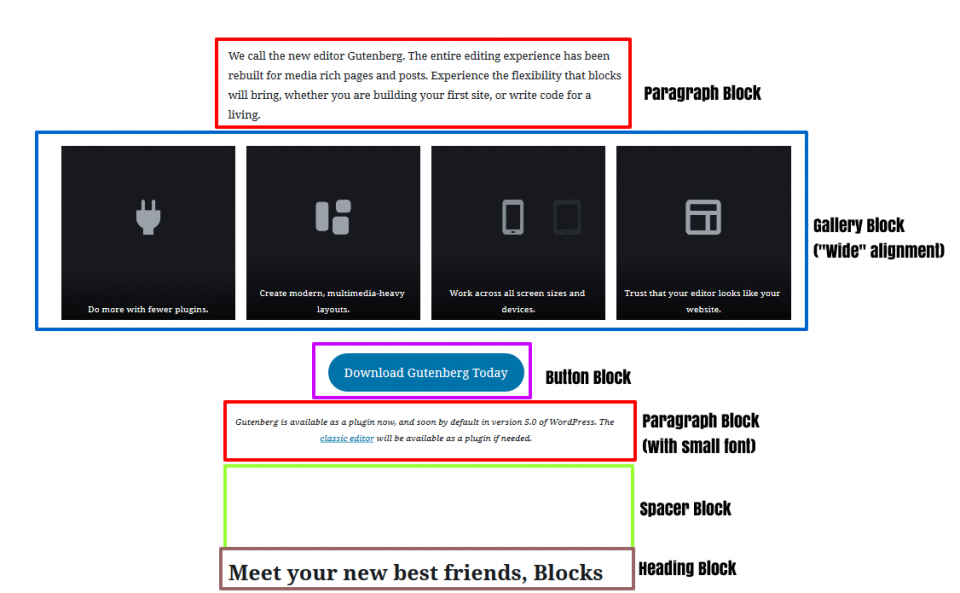Why? Because it includes a new interface for writing and editing your Posts and Pages. After more than two years of development, this new “block editor” (codenamed “Gutenberg”) is now available when you upgrade to WordPress 5.0.
So you can picture these changes, take 5 minutes now to experiment with this demo version or watch this introductory video:
1. Upgrade Now. (But Turn off the Editor.)
Keeping WordPress up-to-date is a crucial habit for maintaining a healthy site. Upgrading to WordPress 5.0 is just as important as any other update for the new security patches and bug fixes.
Luckily, you can choose to update WordPress but continuing using the old editor with the Classic Editor plugin. (After installing, be sure to go to Settings > Writing and disable the Block Editor for all users.) If you have an existing site with lots of content, I would recommend you use this plugin until WordPress 5.1 is released before considering the new editor. Many plugins and themes are still working toward full support, and a bit more time will likely make your transition smoother.
Even with the Classic Editor, it’s worth being cautious about this update, so consider doing a full round of testing to understand how your site works with the new editor before doing this.
Once you’re ready to try out the new editor, it’s time to…
2. Develop Your Block X-Ray Vision
In the new WordPress editor, everything is a “block.”
Paragraph? That’s a block. List? A block. Quote? Also a block? Columns!? Blocks in blocks!
When you’re working on a blog post or page, you’ll do well do think in blocks. Based on the stated future plans for WordPress, blocks will only get more important in the coming years.

3. Customize the Editor to Your Liking
Buried in the top-right corner, the three-vertical-dots button hides three critical options to make the editor more friendly for writing:
- “Top Toolbar”
- “Spotlight Mode”
- “Fullscreen Mode”
I’ll admit, I’m preferential to just the first of the three, but you should try out and explore all three. This article from WP Tavern walks you through these options in more detail.
4. You Don’t Have to Go All In
There’s nothing wrong with only dipping a toe into the editor at first. Luckily, our friend “Classic Editor” makes this easy to do! Beyond the ability to disable the new block editor completely, you can also provide editors the option to choose which editor to use.
Once you’ve tested your site (see #1) and know there are no major issues, consider using the block editor for new blog posts and pages, while still using the classic editor for day-to-day content maintenance.
One final “half-way in” option is to use the new block editor but only with a single “Classic” block. What’s the Classic Block? More or less, it’s a way to use the old editor inside the new one. When creating a new post, instead of creating a paragraph, add a “Classic” block and then do all your work in it. The Classic block is a perfect way to start using just a few blocks at a time. For instance, you could have two classic blocks sandwiching the new Gallery block and a button block.
5. Master the “Slash Inserter” Shortcut
As you try out the block editor, this is the first “power user” tip to know.
The normal way to add a new block is to click one of two “+” buttons in the interface and then select the block you want. (Again, go try out the editor demo right now to see what this means in practice.)
But what could easily be 4 clicks and a distraction only requires a few keystrokes! When you want to quickly add a new block, here’s what to do:
- Put your cursor in an empty paragraph block
- Type /
- Now continue typing the name of the block. For instance, “/gall” for “Gallery” or “/but” for “Button”
- When the block you want is highlighted, hit RETURN and your new block is ready to go!
We’re all still learning about WordPress 5.0 and the best way to use its new features! There will almost surely be hiccups along the way, but you can start learning about, trying out, and starting to use the new block editor on your website today!
About the author & Nonprofit WP
Mark Root-Wiley builds websites for nonprofits in Seattle, WA. He created Nonprofit WP to be the go-to resource for nonprofits building and maintaining their own WordPress websites. Check out NonprofitWP.org for tips on planning websites, recommended themes & plugins, blogging best practices, and more!

You must be logged in to post a comment.